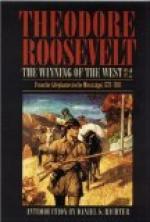The Wars of the Backwoodsmen
The backwoodsmen pressed in on the line of least resistance, first taking possession of the debatable hunting-grounds lying between the Algonquins of the north and the Appalachian confederacies of the south. Then they began to encroach on the actual tribal territories. Every step was accompanied by stubborn and bloody fighting with the Indians. The forest tribes were exceedingly formidable opponents; it is not too much to say that they formed a far more serious obstacle to the American advance than would have been offered by an equal number of the best European troops. Their victories over Braddock, Grant, and St. Clair, gained in each case with a smaller force, conclusively proved their superiority, on their own ground, over the best regulars, disciplined and commanded in the ordinary manner. Almost all of the victories, even of the backwoodsmen, were won against inferior numbers of Indians. [Footnote: That the contrary impression prevails is due to the boastful vanity which the backwoodsmen often shared with the Indians, and to the gross ignorance of the average writer concerning these border wars. Many of the accounts in the popular histories are sheer inventions. Thus, in the “Chronicles of Border Warfare,” by Alex. S. Withers (Clarksburg, Va., 1831, p. 301), there is an absolutely fictitious account of a feat of the Kentucky Colonel Scott, who is alleged to have avenged St. Clair’s defeat by falling on the victorious Indians while they were drunk, and killing two hundred of them. This story has not even a foundation in fact; there was not so much as a skirmish of the sort described. As Mann Butler—a most painstaking and truthful writer—points out, it is made up out of the whole cloth, thirty years after the event; it is a mere invention to soothe the mortified pride of the whites. Gross exaggeration of the Indian numbers and losses prevails even to




